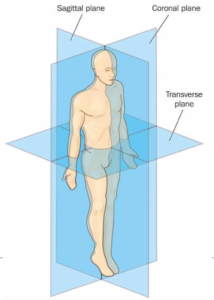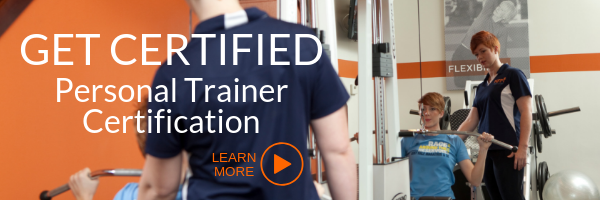The human body is meant to move in all directions – forward, backward, side to side, up, down, and rotationally. In other words, the body exists and functions on a 3-dimensional plane. The term “planes of motion” is used in the context of Human Anatomy and Biomechanics to illustrate this concept. Personal trainers can and should use the three planes of motion when programming for their clients. In doing so, clients will achieve greater stability and mobility, reduced risk of injury and overuse, and enhanced performance.
Traditionally, exercise programming has focused on muscle groups (versus joint actions). For example, training chest, shoulders, and triceps on one day, then legs, back, biceps on another day. Or, training lower body every other day and upper body on the opposite days. Both approaches are standard muscle group-based programming.
This is not to say this type of strategy is “wrong” or “bad” – it’s definitely not. But what might change (for the better) if we focus on joint actions in the three planes of motion, thereby creating a 3D training program? How will this enhance a client’s performance? Or correct muscle imbalances?
The Planes of Motion Defined
 The body is divided into three planes.
The body is divided into three planes.
- The Sagittal Plane. This plane divides the body into right and left halves. The joint actions occurring in this plane include flexion, extension, dorsiflexion, and plantarflexion. Most traditional programs favor movements occurring in this plane (i.e. squats, lunges, curls, leg extension, leg curls, etc.).
- The Frontal (or Coronal) Plane. This plane divides the body into anterior and posterior segments. Movements of this plane include adduction and abduction, elevation and depression (scapular), inversion and eversion, radial and ulnar deviation, and lateral flexion. Movements such as lateral raises, side bends, lat pulldown, pull-up, and shoulder press occur in the frontal plane.
- The Transverse (or Horizontal) Plane. This plane divides the body into superior and inferior halves. This plane is responsible for supination and pronation, horizontal abduction and adduction (also known as horizontal extension and flexion), external and internal rotation, and medial and lateral rotation. Exercises such as bench press, bicycles or oblique crunches, and cable fly or chest fly all occur in the transverse plane.
Keeping the Planes of Motion Straight
Identifying in which plane of motion an exercise occurs frequently can be a sticking point. Think about it this way: Using the sagittal plane as an example, imagine a visible line drawn down the center of the body or a sheet of glass inserted from the head to the toes, separating right from left. Movements that occur parallel to that line (or sheet of glass) take place in the sagittal plane.
Essentially, any forward and backward motion happening parallel to that line, like walking, bicep curls, or deadlifts occur in the sagittal plane.
The same approach works for the two other planes. Use an imaginary line to divide the body into the frontal or transverse planes. Movements that occur parallel to that line occur in that respective plane. For the frontal plane, it’s lateral movements (like shoulder abduction) and for the transverse plane, it’s rotational movements (like a chop or even a bench press) that run parallel to that plane.
Keep practicing! Think of as many exercises or movements as you can and determine which plane they operate in.
Taking a Planar Approach
Here are some basic principles you can apply to design a 3D program for yourself and your clients.
- Focus on multi-joint movements/compound exercises or, those movements that involve a number of muscle groups at one time. The muscles responsible for only one movement will undoubtedly be used as assistants and stabilizers in the larger movements.
- Try to work the “rule of thirds”. If you construct the program with a planar view, you can devote about 1/3 of the session to transverse movements, 1/3 to frontal plane movements, and 1/3 to sagittal plane movements. Of course, the workout doesn’t have to be exactly split into thirds. This is just a guideline.
- Get creative and use movements that occur in more than one plane. For example, instead of a basic forward or reverse lunge, do a forward lunge with a medicine ball rotation (this targets the sagittal and transverse planes in one motion).
- Focus on the major joints of the body that are capable of moving in multiple directions (hips, shoulders, and trunk vs knees & elbows only).
- Use a variety of equipment. Step outside the machine weights or free weights and bring on the kettlebells, stability balls, medicine balls, resistance bands and resistance loops.
The human body is a dynamic machine meant to move in dynamic ways, and utilizing all planes of motion in programming will support a holistic outcome. By primarily training clients in the sagittal plane (with forward and backward/flexion and extension) movements, we are unintentionally facilitating the development of muscle imbalances, limited mobility, and uncoordinated movement in the inadvertently neglected planes. Apply the planar approach and you will have a complete, well-balanced programmatic lens through which to craft future workouts.
Dr. Erin Nitschke, NFPT-CPT, NSCA-CPT, ACE Health Coach, Fitness Nutrition Specialist, Therapeutic Exercise Specialist, and Pn1 is a health and human performance college professor, fitness blogger, mother, and passionate fitness professional. She has over 15 years of experience in the fitness industry and college instruction. Erin believes in the power of a holistic approach to healthy living. She loves encouraging her clients and students to develop body harmony by teaching focused skill development and lifestyle balance. Erin is also the Director of Educational Partnerships & Programs for the NFPT. Erin is an editorial author for ACE, IDEA, The Sheridan Press, and the Casper Star Tribune. Visit her personal blog at belivestaywell.com


